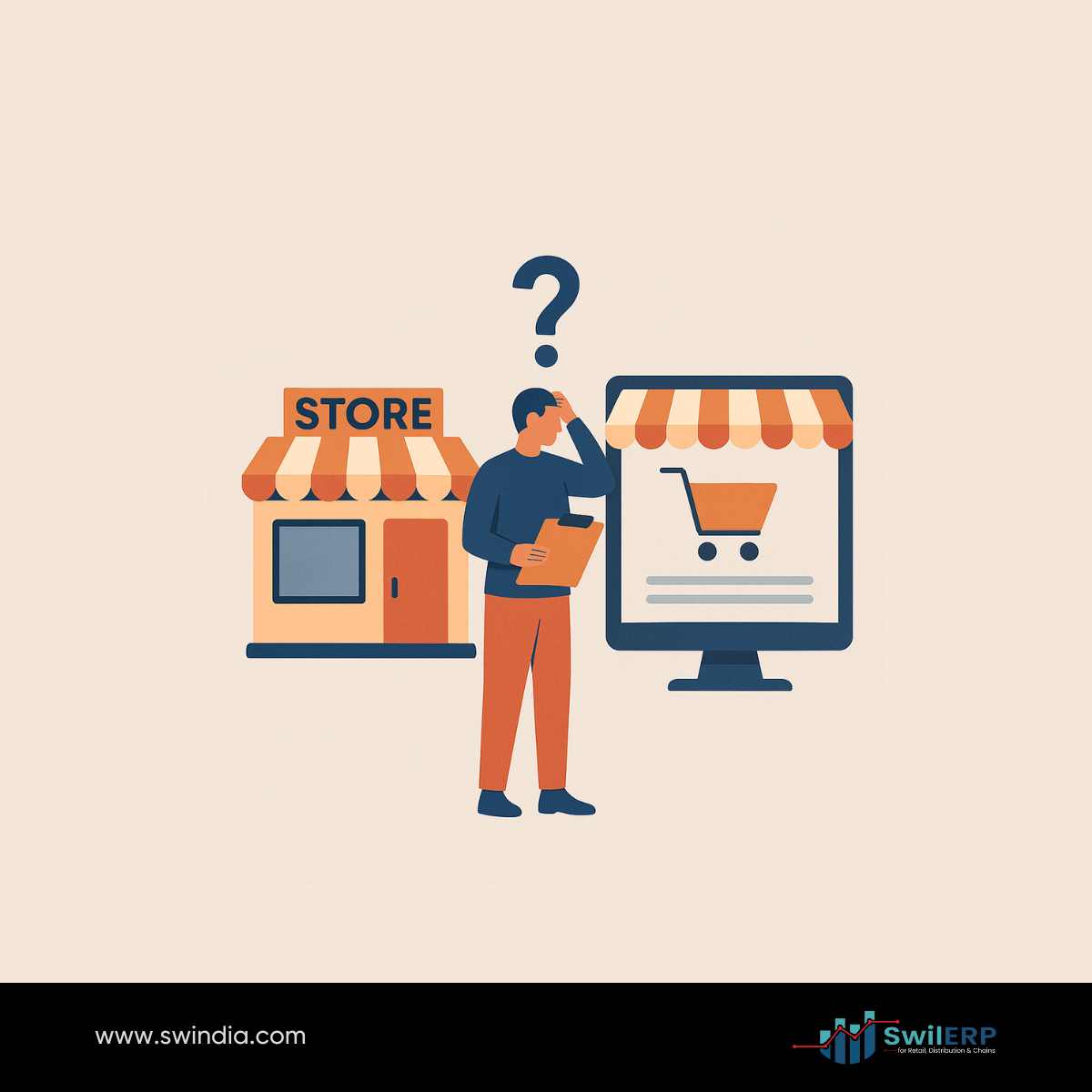Running a business that combines an online Shopify store with a physical retail location can offer many benefits. However, there are also many challenges. Mistakes in day-to-day operations—especially common Shopify retail store mistakes—can lead to loss of money, missed opportunities, and lower customer satisfaction.
This blog discusses the most common mistakes made by businesses operating both online and offline and how to avoid them. The layout is structured to make reading easy and clear for all age groups.
Mistake 1: Poor Inventory Management in Shopify Retail

When online and in-store inventories are not synced, it can lead to problems such as overselling, stockouts, and customer dissatisfaction. For example, if a product sells out in-store but is still marked as available online, it creates a negative experience for online customers.
Solution: Use a POS (point-of-sale) system that syncs inventory in real-time between your Shopify store and physical outlet. This helps keep track of your stock and prevents miscommunication.
Additional Tips:
- Schedule regular stock audits.
- Use barcode scanners to reduce human error.
- Set reorder alerts for fast-selling items.
Mistake 2: Inconsistent Branding and Messaging
Some businesses create separate experiences for online and offline customers. This can lead to confusion and weak brand recognition.
Solution: Use the same logo, color scheme, tone of voice, and promotional content across both platforms. Customers should feel that they are interacting with the same brand whether they are shopping online or in-store.
Practical Advice:
- Use Shopify themes that match your physical store design.
- Train your in-store staff to speak about promotions listed online.
- Offer the same loyalty benefits both online and offline.
Mistake 3: Ignoring Data Analytics
Many businesses do not take full advantage of the data available from their online and offline stores. This results in missed sales opportunities and poor decision-making.
Solution: Shopify provides data on customer behavior, popular products, and abandoned carts. These reports guide marketing efforts, pricing strategies, and stock planning.
Extra Tip:
- Use Google Analytics along with Shopify reports to understand where your online visitors come from and how they behave.
Read also: Why is Comparing Financial Statements from Previous Years Important?
Mistake 4: Delayed Customer Service
Poor customer support, whether online or in-store, can damage your business reputation. Not responding to emails, chats, or refund requests on time is a common issue.
Solution: Set up automated replies and response time expectations. Train your staff to respond to queries in a polite and timely manner. Use customer service tools like Zendesk or Gorgias to manage inquiries.
Mistake 5: Neglecting Mobile Optimization
A large number of online shoppers use mobile phones. If your Shopify store is not optimized for mobile users, you may lose potential sales.
Solution: Choose a mobile-friendly Shopify theme. Test your website regularly on different devices to check loading speed and ease of navigation.
Things to Check:
- Product images should load quickly.
- Buttons should be easy to click on small screens.
- The checkout process should be simple.
Mistake 6: Weak In-Store Digital Experience
Some physical stores do not take advantage of digital tools. This makes their in-store experience outdated and less engaging.
Solution: Use digital displays, self-checkout options, and QR codes that lead customers to your Shopify store. Let customers check online reviews or product details in-store through tablets or phones.
Suggestions:
- Display QR codes on shelves to redirect customers to online product pages.
- Use iPads at checkout counters for product recommendations.
Read also: Why is ERP Software Important + Cost Breakdown
Mistake 7: Complicated Returns and Exchanges
Customers expect an easy return and exchange process. Making it difficult can harm trust and future sales.
Solution: Offer clear policies that work both online and offline. Allow returns through either channel regardless of where the purchase was made.
Tips:
- Make return policies visible on receipts and websites.
- Provide pre-filled return labels for online orders.
- Train store staff on return procedures.
Mistake 8: Not Using Automation Tools
Doing everything manually, from stock updates to email marketing, takes time and increases errors.
Solution: Automate tasks wherever possible. Use Shopify apps for tasks like sending order confirmations, collecting reviews, and updating inventory.
Examples:
- Klaviyo for email marketing automation.
- Oberlo for product sourcing.
- Rewind for automatic backups.
Mistake 9: Lack of Staff Training
Retail staff often don’t receive training on Shopify tools or the customer experience expected online.
Solution: Make sure your staff understands how to use Shopify’s POS system. Train them on your products, policies, and how to handle common customer issues.
Ideas:
- Provide monthly workshops.
- Create quick-reference guides for in-store use.
- Let staff try the online shopping experience to better explain it to customers.
Mistake 10: No Local SEO Strategy
Many retail businesses forget to focus on local search engine optimization (SEO). This causes them to miss nearby customers looking for their products.
Solution: Register your business with Google My Business. Use keywords that include your location on your website and blog.
Checklist:
- Add your store address to the website footer.
- Collect Google reviews.
- Use location-specific content in blogs or product pages.
Mistake 11. Using the Wrong Tools or Software
The problem:
- The tools used do not support Shopify or the physical store.
- Data is stored in different systems.
Results in:
- Extra work and risk of human error.
Suggestions:
- Choose tools that support integration with Shopify.
- Avoid switching between many tools—look for all-in-one solutions.
Reminder: Test software features before buying them.
Mistake 12. Poor Customer Service Consistency
What goes wrong:
- Online customer service replies are fast, but in-store help is slow—or vice versa.
Why it’s bad:
- Affects trust and satisfaction.
How to fix it:
- Set simple response time goals.
- Provide scripts and guidance for all staff.
- Use help desk tools like Zendesk or Gorgias that link with Shopify.
Mistake 13. Not Planning for Peak Seasons
Mistake:
- No preparation for festivals or seasonal sales.
Impact:
- Stockouts, delivery delays, and poor service.
Action steps:
- Order stock early.
- Hire part-time help if needed.
- Set up promotions in advance and test all systems.
Mistake 14. Not Collecting Feedback
Missed opportunity:
- No feedback from online or in-store shoppers.
Result:
- The business doesn’t know what to improve.
Fixes:
- Use feedback forms at checkout.
- Send follow-up emails with short surveys.
- Read and reply to reviews on social platforms.
Mistake 15. Payment and Checkout Problems
Issues include:
- Limited payment options.
- Checkout errors.
- Slow in-store billing.
Fix:
- Offer UPI, card, and wallet options.
- Use a stable internet connection.
- Maintain hardware like card swipers and receipt printers.
Mistake 16. Poor Shipping and Fulfillment Setup
Shipping problems such as delays, high fees, or lack of tracking create frustration among customers.
Solution:
- Offer multiple delivery options.
- Use Shopify’s integrated shipping solutions to print labels and provide tracking.
- Inform customers about delivery timelines and costs before they check out.
Extra Advice:
- Use local courier partnerships for faster delivery.
- Monitor customer feedback related to delivery service and improve regularly.
Mistake 17. Ignoring Customer Feedback
Many businesses fail to collect or act on customer reviews. This can result in repeating the same mistakes and missing improvement opportunities.
Solution:
- Use apps that collect reviews after a purchase.
- Thank customers for their feedback.
- Respond to negative reviews with a polite and helpful tone.
Bonus Tip:
- Display positive reviews on your website or in-store banners to build trust.
Mistake 18. Weak Financial Planning
Businesses often ignore detailed planning of cash flow, taxes, and cost tracking. This affects both profitability and growth.
Solution:
- Use accounting software like QuickBooks or Zoho Books.
- Track all expenses, including small ones.
- Maintain a budget and forecast sales regularly.
Good Practice:
- Reconcile Shopify payouts with bank deposits.
- Hire a part-time accountant if needed.
Summary Table
Common Mistakes in Shopify + Retail Storefront Operations
| Category | Common Mistakes | Impact on Business |
|---|---|---|
| Inventory Management | – Not syncing online and offline stock- Inaccurate stock tracking | Overstocking or stockouts, customer dissatisfaction |
| Customer Experience | – Poor return and exchange policies- Slow in-store service | Decreased loyalty and repeat purchases |
| Technology Integration | – Using disconnected systems for POS, CRM, and inventory- Ignoring updates | Data mismatches, operational delays |
| Pricing and Promotions | – Not aligning online and in-store pricing- Confusing discounts | Reduced trust, lower sales |
| Marketing and Branding | – Inconsistent branding- Not using local SEO or in-store campaigns | Weak brand recall, low local engagement |
| Staff Training | – Inadequate POS and product knowledge- Lack of customer service training | Poor service, increased errors |
| Data and Reporting | – Not tracking key metrics- Relying only on manual reports | Missed growth opportunities |
| Returns and Refund Handling | – Complicated return processes- Not offering omnichannel refunds | Frustrated customers, lost trust |
| Checkout and Payment Experience | – Limited payment options- Long in-store wait times | Cart abandonment, lost sales |
| Website and Mobile Experience | – Slow website- Poor mobile layout | High bounce rates, fewer conversions |
| Logistics and Delivery | – Delayed or inaccurate deliveries- Lack of tracking information | Bad reviews, fewer repeat orders |
| Loyalty and Retention | – Ignoring past customer data- No loyalty or rewards program | Missed upsell opportunities |
| Visual Merchandising | – Cluttered physical layout- Not aligning with online product display | Confusion, reduced purchase rate |
| Omnichannel Coordination | – Separate stock pools- No buy-online-pickup-in-store (BOPIS) option | Disconnected experiences, operational complexity |
| Security and Compliance | – Weak data security practices- Not following data protection laws | Legal risks, customer data breaches |
Conclusion
Running a business with both Shopify and a retail store requires attention to many small details. Mistakes can easily happen when online and offline operations are not managed together. By avoiding the mistakes listed in this blog, you can build a smoother business and create a better experience for your customers.
Use simple tools that connect both your store types. Train your team regularly. Keep learning from customer feedback. These habits will help your business grow stably.








